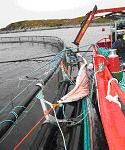Delousing system for cages and well boats
A contributing factor to resistance development of lice in fish farms are suboptimal delousing technology. From 01/01/2011 Norwegian Food Safety Authority requires that the treatment shall take place in closed units to ensure that all the fish are exposed to a therapeutic dose. It is also expected that there in the future will be greater demands on collecting lice.
|
SINTEF Fisheries and Aquaculture contributes with knowledge and tools to develop more robust solutions for closed delousing in large cages, including using our expertise in hydrodynamics, flow, materials science, engineering, product design and hosting operation. An important facility in the effort to explore issues related to the deformation of the nets and cover, is the institute's flow tank in Hirtshals. |

|
Molecular effects on plankton organisms
Testing of new lice treatment will benefit from the best possible methods to study the effects of the chemicals on the lice, salmon and other organisms in the local environment around the salmon plant. SINTEF has initiated a corporate focus where established methods for studying the molecular effects of chemicals on organisms by means of DNA and metabolite analysis.
The methods developed are relevant to the testing of lice treatment. The effects can be detected before it is possible to observe responses in tests that are based on visual observation. An important element of molecular methods is to find mechanisms for how a particular lice treatment works on lice, but also to investigate whether a molecular level affect salmon and other species in the ecosystem.
